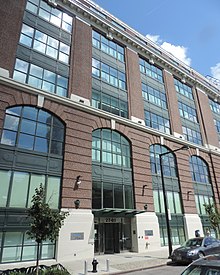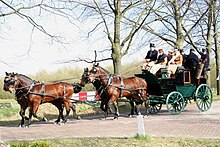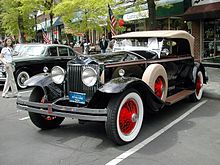Brewster & Co.
| Brewster & Company | |
|---|---|
| legal form | Company |
| founding | 1810 |
| resolution | 1936 |
| Reason for dissolution | insolvency |
| Seat | New York , USA |
| Branch | Body shop |
Brewster & Co. (also: Brewster & Company ) was an American body construction company that initially manufactured carriages and, in the 20th century, custom bodies for luxury automobiles. Brewster was one of the most exclusive body manufacturers in the country in the period after the First World War . The name Brewster was at times synonymous with luxury and elegance in the USA. Brewster was closely associated with Rolls-Royce in the 20th century . At times the company was also active as an automobile manufacturer under its own name.
Company history
Beginnings as a carriage manufacturer
James Brewster (1788-22 November 1866), a former lieutenant in the US Army , trained as a wheelwright from 1804 to 1809 at a company in Massachusetts . From 1809 he worked as a sales representative for a carriage manufacturer from New Haven ( Connecticut ) before he founded the Brewster Carriage Company in New York in 1810 with the support of a silent partner , which manufactured carriages. Brewster's carriages had a good reputation early on. After a substantial part of the factory was destroyed by fire in 1836, Brewster ceased operations for two years. The company was reorganized in 1838 with the help of a New York investor, but quickly fell into financial collapse and was bankrupt just four years later. In 1846 the company was re-established under the name James Brewster & Sons , which developed successfully thanks to the good reputation of James Brewster , who was still working for the company. Brewster took over several competitors in the 1850s, including the New York carriage manufacturer Lawrence & Townsend , which was operated independently from James Brewster & Sons under the name Lawrence & Brewster .
Division into competing companies
In 1856, after differences of opinion between the sons of the company founder, another restructuring took place, which was connected with a division into two companies:
- Henry Brewster took over parts of the existing business and continued it as Brewster & Company .
- His brother James Benjamin Brewster founded the independent company James B. Brewster (later: JB Brewster & Co.) with the involvement of individual branches.
Both companies existed in parallel in the following decades, competed with each other for comparable customers and repeatedly brought proceedings against each other, including the rights to use the name Brewster. While James B. Brewster went bankrupt twice and was finally dissolved in 1908, Brewster & Company was economically stronger and successfully implemented the change from a carriage manufacturer to a manufacturer of automobile bodies at the beginning of the 20th century. Brewster & Co. applied with the slogan The Carriage Builder for the American Gentleman .
Adaptation to the automotive market
Brewster & Company dressed the first automobile in 1896. It was a body for a prototype with an electric motor. From 1905 Brewster imported automobiles from Delaunay-Belleville , the leading French automobile manufacturer at the time. Brewster has received regular orders from importers of European luxury vehicles since the beginning of the 20th century. Brewster bodyworked chassis from Mercedes , Panhard & Levassor , Renault , Simplex and similar brands during this time .
Brewster and Rolls-Royce
In 1914, Brewster became the sole importer for Rolls-Royce and, based on the North American market, the preferred body supplier for the British luxury manufacturer. Brewster's role in Rolls-Royce superstructures in the United States was roughly equivalent to that of Barker in the United Kingdom . Until the 1920s, Rolls-Royce was a focus of activity for Brewster. Brewster regularly offered a whole range of different bodies, ranging from the two-seater convertible to the sedan. Stylistically, the designs were predominantly considered to be conservative; in the late 1920s, however, a few unusual bodies were added.
The relationship with Rolls-Royce changed after the end of the First World War. From 1921 Rolls-Royce chassis no longer had to be imported into the USA. Rather, Rolls-Royce had its own subsidiary ( Rolls-Royce of America ) in Springfield , Massachusetts , which manufactured its own chassis for the North American market. For these chassis too, Brewster produced high-quality, but now largely standardized bodies, which had been designed by Carl Beck and JS Inskip and which, according to observers, were among the most beautiful Rolls-Royce ever built. By eliminating imports, Brewster lost the ability to influence pricing. This significantly reduced the company's profits, so that Brewster was taken over by Rolls-Royce in 1926. The purchase price for the company was $ 202,000, with about two-thirds of it being on outstanding bills. The production of the bodies continued in Brewster's facilities in the New York borough of Queens ; they were quasi-factory superstructures. Regardless of the Rolls-Royce affiliation, the superstructures continued to be referred to as Brewster bodies. In the late 1920s, the combination of the Rolls-Royce chassis and Brewster bodies was successful. However, in the wake of the Great Depression in 1930/31, sales collapsed. Rolls-Royce of America closed in 1931, and two years later the body shop at Brewster ended. From 1914 to 1937 about 415 Rolls-Royce chassis were dressed by Brewster.
The past few years: Springfield Manufacturing and JS Inskip Inc.
The company was renamed Springfield Manufacturing Corporation in August 1934 . JS Inskip, who was temporarily sales manager at Rolls-Royce of America in the 1920s and, after its dissolution, Rolls-Royce importer, became the company's manager. During this time, a few more Rolls-Royce bodies and a three-digit number of sports cars with Ford technology were created, which were sold as Brewster, but were not successful on the market.
In 1935 Brewster or Springfield Manufacturing was insolvent. After an interim period in which the company was owned by Dallas E. Winslow and linked to Pierce-Arrow , it was resolved into bankruptcy. From the bankruptcy, JS Inskip, who at the same time became New York's sole importer for Rolls-Royce, took over a substantial inventory of materials from Brewster, as well as numerous former Brewster employees and some unsold chassis from Rolls-Royce of America. On this basis, he founded JS Inskip Inc. in New York in 1937 , a body manufacturer that continued to clad Rolls-Royce chassis in the Brewster tradition. In 1967, the connection between Inskips and Rolls-Royce ended. The company stopped the body shop. The company still exists. It is based in Rhode Island , is now owned by Roger Penske and is now a dealer for high-quality European automobiles.
Brewster as an automobile manufacturer
Brewster Knight
From 1915 to 1925 produced Brewster marketed under its own name Brewster Knight , a vehicle with key motor of Knight .
Brewster Town Car: Springfield Manufacturing Corporation
After separating from Rolls-Royce, banks recommended closing the company. JS Inskip, the newly appointed President of Springfield Manufacturing, tried to keep operations going. He developed the idea of equipping the chassis of the mass production manufacturer Ford with sensational special bodies that were to be manufactured at Springfield. The models were to be sold under the Brewster brand name.
The car called Brewster Town Car was based on the elongated, but technically unchanged chassis of the Ford Model 40B . The body, the design of which goes back to Carl Beck, had curved fenders and a striking, heart-shaped grille. Most of the bodies were two-door coupés, with a few convertibles. The cars were offered in the sales rooms of the American Rolls-Royce dealers. You were referred to as Brewster; a relationship with Ford was not externally recognizable. The cars were very expensive: their retail price was over $ 3,000 each; so one car cost as much as five Ford B.
According to JS Inskip, the initiator of the Town Car, around 300 vehicles of this type were built; other sources consider this to be too exaggerated and assume only 140 vehicles, of which 39 should still exist. Individual bodies are also said to have been placed on Buick chassis . This too is sometimes doubted; It is sometimes claimed that in these cases the bodies were subsequently moved to younger chassis a few years later.
The income from the sale of the Ford models fell short of expectations. After a year and a half, the company was insolvent.
Brewsters designer
Several well-known American automobile designers began their careers at Brewster. They included Henry Brunn , James Way (later head of design at Pierce-Arrow ) and Raymond Dietrich . Henry Crecelius Sr. Brewsters was chief designer until the takeover by Rolls-Royce. In 1925 he switched to Ford's luxury brand Lincoln . His successor at Brewster was Carl Beck. He stayed with the company after the restructuring and designed superstructures for both Springfield Manufacturing and JS Inskip Inc.
Importance of the company
The name Brewster was at times synonymous with luxury and elegance. One observer highlighted the company's importance by comparing it to Tiffany & Co. jeweler :
- Some consider Brewster to be the bodybuilder's Tiffany. I think Tiffany is the Brewster jewelers.
Cole Porter used Brewster as a synonym for excellence in the musical Anything Goes . The song You're The Top reads:
-
You're the top!
You're a Ritz hot toddy.
You're the top!
You're a Brewster body .
literature
- Richard M. Langworth: Automobiles of the 1930s. Beekman House, New York 1980, ISBN 0-517-309947 .
Web links
Individual evidence
- ↑ a b c company history on the website www.coachbuilt.com (accessed on July 1, 2015).
- ↑ a b Company history on the website www.coachbuild.com (accessed on July 1, 2015).
- ↑ a b c d biography of JS Inskip on the website www.coachbuilt.com (accessed on July 2, 2015).
- ↑ Images of the Brewster Town Car on the website www.coachbuild.com (accessed July 1, 2015).
- ^ Richard M. Langworth: Automobiles of the 1930s . Beekman House, New York 1980. ISBN 0-517-309947 , p. 94.




